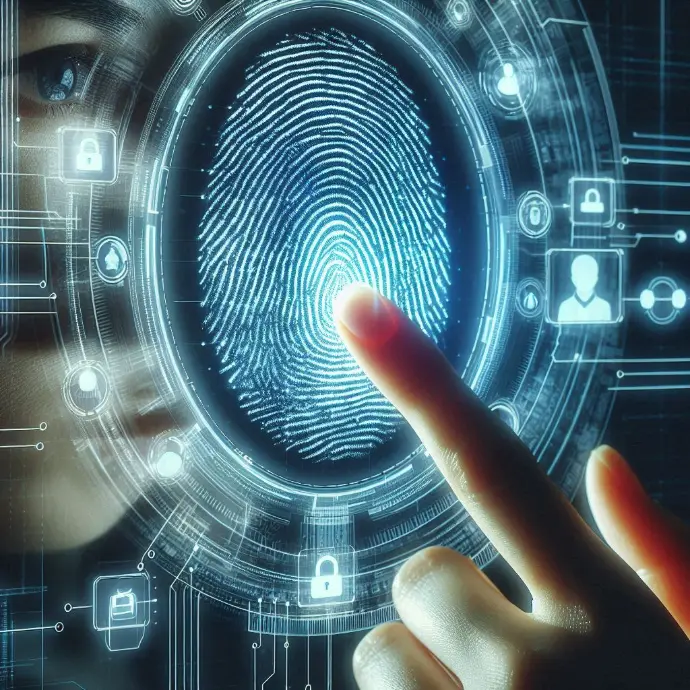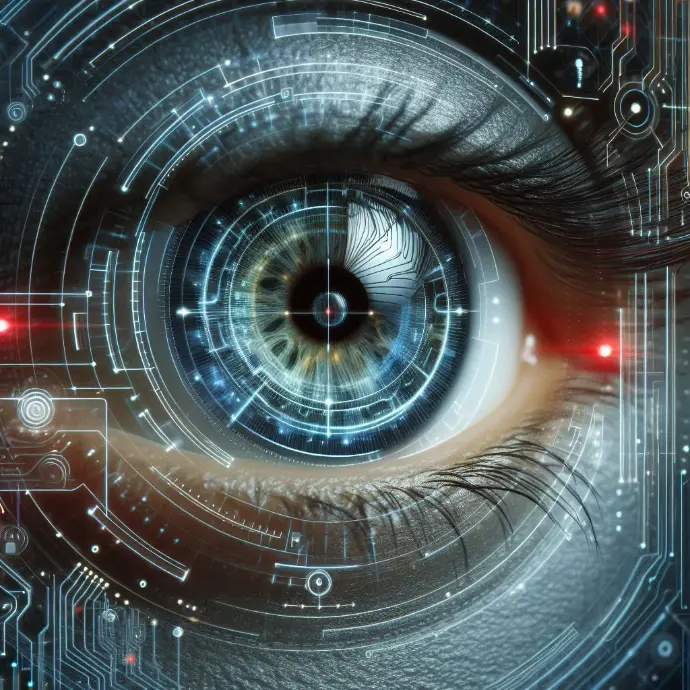The Future of Authentication: Biometric Recognition and Personal Security
Here you'll find a fascinating tour of the wonders and challenges of emerging technologies. In our feature article, "The Future of Authentication: Biometric Recognition and Personal Security," we'll explore how biometric recognition is revolutionizing cybersecurity and ensuring personal protection. Ready to delve into the exciting world of security and future technology? Keep exploring and discover more about this fascinating topic!
Introduction
Currently, authentication technology is undergoing significant advances that are revolutionizing the way people protect their data and personal information. One of the most notable developments in this field is biometric recognition, which offers high levels of personal security by using unique physical features to authenticate an individual's identity. This technological advancement not only represents an innovative way to protect information but also poses important challenges and considerations in the field of cybersecurity.
Biometric recognition has emerged as one of the most promising technologies in the field of personal authentication. By using unique physical characteristics, such as fingerprints, facial scans, voice recognition, and even behavioral patterns, biometric recognition offers an exceptional level of security. Unlike passwords or PINs, biometric features cannot be forgotten, shared, or stolen, making them a highly secure option for personal authentication.
Furthermore, the evolution of biometric technology has enabled its integration into a wide range of devices and applications, from smartphones and laptops to access control systems in businesses and government settings. This accessibility and versatility have led to significant growth in the adoption of biometric authentication across various sectors, demonstrating its positive impact on personal security and the protection of sensitive data.
While biometric recognition offers numerous benefits in terms of personal security, it also poses challenges related to privacy and data protection. The secure storage and management of biometric information are critical aspects that must be addressed to ensure the integrity and confidentiality of individuals' biometric data.
In today's digital age, personal security has become a key priority for individuals, businesses, and organizations. The rise in cyberthreats and the risks associated with identity theft and privacy intrusion has generated greater awareness about the importance of implementing strong security measures. In this context, biometric recognition is emerging as a key tool for strengthening personal security and effectively protecting confidential information.
Biometric authentication not only offers a higher level of security compared to traditional methods but also provides a more convenient and efficient user experience. By eliminating the need to remember complex passwords or access codes, biometric recognition simplifies the authentication process, resulting in greater convenience for users while strengthening the protection of their identity and personal data.
Biometric recognition represents a significant advancement in authentication technology, offering high standards of personal security in an increasingly complex digital environment. While its implementation poses challenges in terms of privacy and data management, its potential to strengthen the protection of confidential information positions it as a crucial tool in the field of cybersecurity.
Personal security through biometric recognition
Biometric recognition is an authentication method based on an individual's unique physical or behavioral characteristics, such as fingerprints, facial recognition, iris scans, or voice. These characteristics are used to verify a person's identity and provide access to restricted devices, systems, or areas.
This biometric authentication approach has gained popularity in recent years due to its high accuracy and its ability to provide an additional level of security compared to traditional password or access card methods.
Biometric recognition has become a fundamental technology in the field of personal security and the protection of sensitive data.
Biometric recognition is applied in a variety of scenarios to improve personal security. A common example is unlocking smartphones using facial or fingerprint recognition. This technology is also used in building access control systems, where retinal or fingerprint scanning ensures that only authorized individuals can enter restricted areas.
Furthermore, biometric recognition has been implemented in airports to streamline security screening processes, allowing travelers to use their faces as identification instead of physical documents. In the healthcare field, this technology is used to ensure accurate patient identification and secure access to their medical records.
Biometric recognition has emerged as a versatile tool for strengthening personal security in a variety of contexts, from mobile devices to critical infrastructure.
Biometric recognition offers several significant benefits for personal security. First, it eliminates the need to remember complicated passwords, thus reducing the risk of identity theft and cyberattacks. Furthermore, as a technology based on the unique characteristics of each individual, biometric recognition provides an exceptional level of accuracy in identity verification.
Another important benefit is the convenience it offers users. Instead of relying on access cards or keys, biometric recognition allows for quick and frictionless access to secure devices and areas.
Finally, biometric recognition can improve personal security by reducing the risk of identity theft and fraud, as biometric characteristics cannot be easily duplicated or shared. This gives individuals greater control over their personal information and digital assets.
Biometric recognition has proven to be an effective way to strengthen personal security, but it also faces significant challenges and limitations. Among the most notable challenges is the accuracy of biometric recognition. Although technology has advanced considerably, there are still situations in which biometric recognition can fail, whether due to lighting problems, physical changes in the person, or the quality of the biometric sample.
Another major challenge is the privacy and protection of biometric data. The collection and storage of biometric data raises concerns about the possibility of misuse or unauthorized access to this highly sensitive information. Protecting the privacy and security of biometric data is crucial to ensuring public confidence in this technology.
Furthermore, the cost of implementing biometric recognition systems can be prohibitive for many organizations and individual users. Purchasing specialized hardware and developing custom software can be expensive, limiting widespread adoption of this technology, especially in resource-limited settings.
Emerging Technologies in Biometric Recognition
Facial recognition is one of the most popular and promising biometric technologies today. Thanks to the ability of artificial intelligence algorithms to analyze and compare unique facial features, it has become a widely used tool in personal and business security. Advances in this technology have allowed for greater accuracy and speed in identifying individuals, making it ideal for access control applications, payment systems, and mobile devices.
Furthermore, facial recognition is being implemented in airports and borders to streamline immigration control processes, improving security and efficiency. Despite its benefits, facial recognition poses ethical and privacy challenges, which has sparked debates about its use in society.
Currently, leading technology companies such as Apple, Google, and Microsoft are investing significant resources in the development of increasingly sophisticated facial recognition systems, indicating a promising future for this technology in the fields of personal security and digital identification.
Voice recognition, a unique form of biometrics based on physiological characteristics, is experiencing significant advancements. Voice recognition technology has become popular through virtual assistants such as Siri, Alexa, and Google Assistant, which use this technology to understand and respond to users' verbal commands.
In the field of personal security, voice recognition is being used to authenticate users in restricted access systems, such as unlocking mobile devices or verifying identity during phone calls. Developments in this technology have allowed for greater accuracy in identifying individuals through unique voice patterns, making it a promising tool for biometric authentication.
The implementation of voice recognition systems also poses challenges, such as accuracy in noisy environments and the possibility of identity theft. However, constant advances in natural language processing algorithms and vocal pattern understanding promise an increasingly secure and reliable future for this technology.
Fingerprint recognition has been one of the most widespread and reliable forms of biometric authentication for decades. With the advancement of technology, faster and more accurate fingerprint sensors have been developed and integrated into mobile devices, laptops, and security systems.
The convenience and reliability of fingerprint authentication have driven its adoption in a wide range of applications, from unlocking smartphones to accessing secure facilities. Furthermore, the ability of fingerprint sensors to detect unique subcutaneous features has made this technology extremely difficult to counterfeit or replicate.
Innovations in fingerprint recognition have also extended to the field of cybersecurity, where they are used to protect access to devices and applications. As technology continues to evolve, fingerprint recognition is expected to remain a fundamental tool in personal security and biometric identification.
The integration of behavioral biometrics is a significant advancement in the field of authentication and personal security. This technology focuses on measuring and analyzing an individual's unique behavioral patterns, such as the way they type, walk, or interact with electronic devices. By combining behavioral biometrics with other forms of authentication, such as facial or fingerprint recognition, a much more robust security system is created.
Behavioral biometrics not only offers an additional layer of security but also provides a more seamless and frictionless user experience. By not relying on external devices, such as smart cards or security tokens, behavioral biometrics-based authentication simplifies the identity verification process, resulting in greater convenience for users.
Furthermore, the integration of behavioral biometrics into mobile applications, payment systems, and IoT devices is emerging as a growing trend, as organizations seek more secure and convenient authentication solutions in an increasingly digitalized world. As technology continues to evolve, behavioral biometrics promises to play a crucial role in protecting personal security and preventing fraud.
Impact of Biometric Recognition on Cybersecurity
Technological advancements have driven the strengthening of authentication in digital environments through biometric recognition. This method has become a key tool for ensuring personal security and the integrity of information in the digital world.
Biometric recognition offers an additional layer of security by requiring identity verification through unique physical characteristics, such as fingerprints, facial recognition, retinal scans, or voice recognition. These biometric data are extremely difficult to replicate or falsify, significantly reducing the risk of unauthorized access to sensitive devices or data.
Furthermore, biometric recognition not only strengthens security but also improves the user experience by eliminating the need to remember complex passwords or change them regularly. This technology offers a convenient and efficient method for accessing devices and applications, contributing to the protection of personal security in digital environments.
Biometric recognition plays a fundamental role in preventing online fraud and identity theft. By utilizing unique physical characteristics of each individual, such as fingerprints or facial recognition, this authentication method greatly hinders the possibility of third parties fraudulently accessing accounts or sensitive information.
Furthermore, biometric recognition allows for a higher level of certainty in identity verification, resulting in a significant reduction in the risks associated with authentication based solely on passwords or PIN codes. This technology not only protects personal security but also mitigates the possibility of identity theft and online fraud, providing an additional layer of protection in digital environments.
Biometric recognition has become a powerful ally in the fight against fraud and identity theft, providing an effective solution for protecting personal security in the digital world.
While biometric recognition offers significant benefits in terms of security and convenience, its implementation raises important ethical and privacy considerations in the use of biometric data. The collection and storage of biometric information must be carried out with the highest degree of security and confidentiality to ensure the protection of individuals' privacy.
Furthermore, it is essential to establish clear and transparent policies on the use of biometric data, ensuring that users' explicit consent is obtained for the collection and use of this information. Access to and management of biometric data must be subject to strict regulations and security standards to prevent potential privacy breaches and misuse of this sensitive information.
While biometric recognition offers significant advantages in terms of personal security, it is crucial to proactively address ethical and privacy considerations, ensuring that its implementation is based on principles of transparency, informed consent, and data protection.
Biometric recognition, which includes identification based on an individual's unique characteristics, such as fingerprints, facial scanning, voice recognition, and retinal scanning, has seen a significant increase in adoption in security systems. This technology offers an additional layer of protection by requiring identity verification through unique physical or behavioral traits. As cybersecurity becomes more critical in various sectors, such as banking, healthcare, and government, biometric recognition has emerged as an attractive solution to combat fraud and protect users' personal security.
The adoption of biometric recognition in security systems has also been driven by the proliferation of mobile devices. Modern smartphones and tablets are equipped with biometric capabilities, such as fingerprint scanning and facial recognition, bringing this technology directly into the hands of millions of users worldwide. This increased familiarity with biometric authentication has fostered its acceptance and paved the way for its implementation in a variety of scenarios, from unlocking personal devices to accessing sensitive applications and services.
Furthermore, concerns about personal security and the need to combat cyber fraud have led to increased interest in biometric recognition. As traditional authentication methods, such as passwords and PINs, have proven vulnerable to phishing attacks and identity theft, biometric recognition offers a more secure and convenient alternative. The ability to verify identity quickly and accurately, without relying on information that could be compromised, has positioned biometric recognition as a critical tool in protecting personal security and preventing unauthorized access.
Future of authentication and personal security
Multi-factor authentication integration is a fundamental aspect of the future of personal security through biometric recognition. This strategy combines different authentication methods, such as facial, voice, fingerprint, or retinal recognition, with traditional passwords or PIN codes. By combining multiple factors, security is strengthened and the chances of identity theft or unauthorized access are reduced.
Implementing this strategy on mobile devices, building access systems, or digital platforms provides an additional layer of protection that is essential in an increasingly connected world. Furthermore, the integration of multiple authentication factors not only secures the user's identity but also guarantees the confidentiality of personal and financial information.
The complexity and sophistication of this form of authentication make it a fundamental pillar in the development of personal security through biometric recognition, providing a secure and seamless experience for users in different contexts.
Developments in biometric data protection and management are essential to ensuring the security and privacy of personal information. Implementing robust security standards, such as end-to-end encryption and secure storage of biometric data, is critical to prevent unauthorized access and potential vulnerabilities.
Furthermore, biometric data management must comply with privacy regulations and standards, such as the General Data Protection Regulation (GDPR) in the European Union, to ensure informed user consent and the proper handling of their personal information. These developments not only seek to protect the integrity of biometric data but also to foster user confidence in the use of this technology.
The continued evolution of biometric data protection and management techniques is crucial to mitigating potential risks and ensuring the confidentiality of personal information, which will allow for significant progress in the adoption and acceptance of biometric recognition as a secure authentication method.
Trends in biometric recognition implementation point to increased adoption in a variety of fields, from mobile devices and payment systems to applications in the healthcare and banking sectors. Facial, voice, and fingerprint recognition have become key tools for providing a secure and convenient user experience.
Additionally, the development of artificial intelligence and machine learning algorithms has improved the accuracy and reliability of biometric recognition, significantly reducing the possibility of false positives and negatives. This technological evolution is critical to boosting confidence in biometric recognition as a secure and reliable authentication method.
In the corporate world, implementing biometric recognition for access control and attendance management has proven to be an efficient and accurate alternative to traditional methods. This not only contributes to facility security but also streamlines processes and provides an accurate record of staff attendance.
Conclusions
Currently, biometric recognition has proven to be one of the most promising advances in the field of personal security. By using unique characteristics of each individual, such as fingerprints, facial recognition, or retinal scanning, a level of authentication has been achieved that surpasses traditional passwords or ID cards. This advancement promises an unprecedented level of security, as it is extremely difficult to falsify or replicate.
However, despite its benefits, biometric recognition also presents significant challenges. One of the most important challenges to consider is the privacy and secure storage of biometric data. The protection of personal information is crucial, and any vulnerability in storage systems can result in serious consequences. It is essential to develop robust security protocols to ensure that biometric data is effectively protected.
Another important challenge is the need to continue improving the accuracy and reliability of biometric systems. Although they have advanced considerably, there are still scenarios in which biometric recognition can fail, resulting in inconvenience for users. It is essential to invest in research and development to perfect these technologies and ensure their effectiveness in a variety of situations.
The Fundamental Role of Biometric Recognition in Personal Security
Biometric recognition plays a critical role in personal security by offering a level of authentication and protection that surpasses traditional solutions. By utilizing unique biological characteristics, such as fingerprints, facial features, or retinal scans, biometric recognition provides an additional layer of security that is difficult to duplicate or falsify. This is especially relevant in an increasingly digital world, where protecting identity and personal information is of utmost importance.
Furthermore, biometric recognition offers a convenient and efficient user experience. By eliminating the need to remember complex passwords or carry ID cards, the authentication process is considerably simplified. This not only improves user convenience but also reduces vulnerability to phishing attacks and fraud.
Biometric recognition represents a significant advancement in protecting personal security. As it continues to evolve and overcome challenges, it is expected to play an increasingly crucial role in cybersecurity and digital identity protection.



